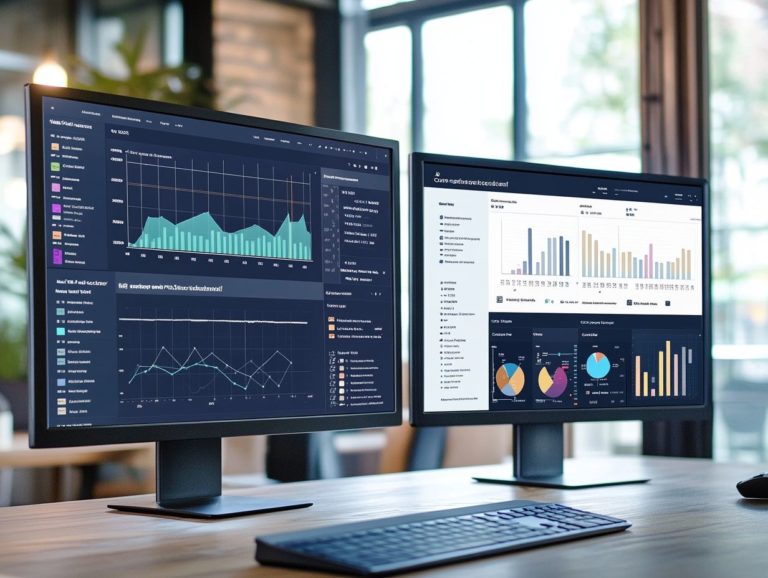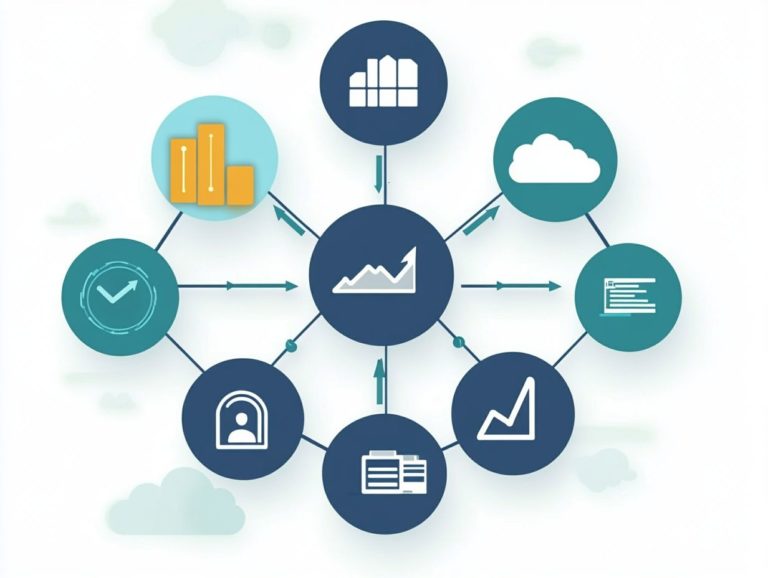How to Create a Cloud Cost Dashboard
In today’s digital landscape, managing cloud costs has become imperative for organizations like yours. A Cloud Cost Dashboard is an invaluable tool that allows you to visualize your spending, optimize resource allocation, and make well-informed decisions.
This article delves into the many benefits of using such a dashboard, ranging from efficient cost management to improved decision-making. You ll find a breakdown of the essential components, a step-by-step guide for creating your dashboard, and best practices for ensuring its continued effectiveness.
Ready to take control of your cloud costs? Let s explore further!
Contents
Key Takeaways:

A cloud cost dashboard is a powerful tool for managing and optimizing costs in the cloud environment. By using a cloud cost dashboard, businesses can efficiently monitor and analyze their cloud spending, leading to better decision-making and cost savings. To create an effective cloud cost dashboard, it is important to identify goals and metrics, choose the right tools and services, and regularly review and update the dashboard with input from the team. For more insights, check out our guide on how to navigate cloud cost complexity.
What is a Cloud Cost Dashboard?
A Cloud Cost Dashboard serves as your visual command center, consolidating and analyzing real-time data on cloud computing expenses. This tool provides valuable insights into your cloud spending, budgeting, and resource allocation, which are crucial for driving better business outcomes. To optimize these processes, consider learning how to develop a cloud cost management plan.
For Financial Operations teams, it s an essential asset that allows for efficient management of cloud financials and effective monitoring of project costs. This ensures that the needs of stakeholders are met while optimizing your cost management strategies.
Integrating tools like AWS Billing shows detailed billing data that reveals trends and anomalies in your expenditures. This insight enables your organization to adopt proactive budgeting strategies that align perfectly with your financial goals and project requirements.
A Cloud Cost Dashboard boosts financial awareness across all departments, enabling your teams to make informed decisions about cloud resource utilization. With features like customizable reports, budget threshold alerts, and historical data analysis, this dashboard not only promotes transparency but also fosters accountability. This ensures that every dollar spent on cloud resources is justified and maximized for value.
Benefits of Using a Cloud Cost Dashboard
Utilizing a Cloud Cost Dashboard presents a wealth of advantages that substantially elevate your organization s cloud cost management and financial decision-making.
This powerful tool enables you to realize significant savings by delivering real-time data insights, facilitating in-depth cost analysis, and optimizing cloud expenditures across multiple providers like AWS, Microsoft Azure, and Google Cloud.
Ultimately, it addresses the needs of your stakeholders while enhancing overall financial awareness within your organization.
Efficient Cost Management
Efficient cost management is essential in cloud computing environments, where you often encounter unpredictable expenses. A Cloud Cost Dashboard enables you to monitor your cloud spending in real time, allowing for informed decisions on budget tracking, cost allocation, and cloud cost optimization ultimately enhancing your overall cost utilization.
By implementing strategies like setting predefined budgets and using automated alerts for overspending, you can ensure you stay within your financial boundaries.
Tools such as AWS Cost Explorer, which helps visualize your costs over time, and Azure Cost Management offer valuable insights into your spending patterns. They help you pinpoint areas where you can cut back or optimize usage.
Adopting a robust tagging strategy gives you better visibility into resource allocation by departments or projects, improving accountability and fostering cost-effective decision-making.
Regular cost audits can uncover hidden inefficiencies, paving the way for continuous improvement and ensuring your cloud investments align with your business goals.
Improved Decision Making
Improved decision-making is a key advantage of utilizing a Cloud Cost Dashboard. It provides actionable cost insights through data visualization and analytics.
By integrating tools like AWS Cost Explorer with other business intelligence platforms, you can create custom dashboards that enhance your understanding of cloud expenses, enabling stakeholders to make informed and strategic decisions on resource allocation and financial planning.
These easy-to-use dashboards allow you to visualize spending patterns and identify trends in nearly real time. This ensures that your financial resources are optimized effectively.
For instance, with Power BI or Tableau, you can craft interactive reports that pinpoint high-cost areas and recommend cost-saving measures. Ultimately, this drives greater operational efficiency.
Such visual analytics simplify complex datasets and deliver crucial insights. This makes it easier for your teams to engage in proactive budget management.
Therefore, adopting these comprehensive tools is essential for cultivating an environment where data-driven strategies effectively steer critical financial outcomes.
Key Components of a Cloud Cost Dashboard

The key components of a Cloud Cost Dashboard are crucial for efficiently managing your cloud expenses and ensuring precise tracking.
Essential elements include:
- Intuitive cost visualization tools
- Robust data collection and analysis mechanisms
- Automated processes that continuously monitor your cloud billing data
Customizable interfaces let you tailor the dashboard to meet specific user needs across cloud platforms like AWS, Microsoft Azure, and Google Cloud.
Cost Visualization Tools
Cost visualization tools are essential for any Cloud Cost Dashboard. They transform complex cloud billing data into clear and intuitive visuals.
By leveraging cloud analytics and dashboard creation techniques, you can craft custom dashboards that provide valuable cost insights. This allows stakeholders to easily understand spending patterns and trends.
These tools employ a variety of visualizations such as bar charts, pie graphs, and line graphs. Each serves a crucial role in illustrating expenses across different cloud services.
Such visual representations simplify data interpretation and illuminate anomalies while uncovering opportunities for savings.
You can tailor custom dashboards to meet the specific needs of various teams or departments. This ensures that vital information is always accessible and actionable.
This personalized approach enables decision-makers to align their cloud strategies with overarching business objectives. Ultimately, this results in more informed and efficient financial management.
Data Collection and Analysis
Data collection and analysis are essential processes for ensuring that your Cloud Cost Dashboard provides accurate and actionable cost insights.
By integrating automated systems to gather real-time data from various cloud billing sources, you can perform comprehensive cost analyses. This allows you to identify spending trends and allocate resources more effectively.
These methods streamline the capture of vital information and enhance the reliability of the data displayed in your dashboard.
With the help of sophisticated tools, you can monitor expenses in real time. This ensures that your financial decisions are based on the most current information available.
Automation minimizes the chances of human error and frees up valuable resources for more strategic initiatives. Armed with real-time insights, you can quickly adapt to spending patterns, optimize your cloud usage, and drive efficiencies that align with your organizational goals.
Steps to Create a Cloud Cost Dashboard
Creating a Cloud Cost Dashboard is an exciting journey that starts by clearly defining your goals and the metrics essential for effective cost monitoring and optimization. For further insights, check out how to implement cloud cost controls.
By choosing the right tools and services like AWS Cost Explorer and designing a visually appealing, tailored dashboard, you can significantly enhance your cloud cost management strategy.
Ultimately, this leads to improved financial outcomes for your organization.
Identify Your Goals and Metrics
Identifying your goals and metrics serves as the cornerstone of crafting an effective Cloud Cost Dashboard. Clear objectives will steer your cloud cost management efforts in the right direction.
By aligning your metrics with organizational goals, you ll be able to track budget allocations more effectively and meet stakeholders’ needs through insightful data reporting.
Understanding your financial priorities is crucial. For instance, you might decide to focus on cost optimization or resource utilization. Metrics like cost per workload, instance utilization rates, and total cloud spend relative to budget are all essential.
By keeping an eye on these metrics, you can pinpoint areas where spending strays from forecasted budgets, allowing you to make timely adjustments.
Establishing benchmarks for expected costs tied to specific projects can provide you with quick insights into performance evaluations. This clarity ensures accountability and fosters a culture of financial discipline within your organization, creating a direct link between spending and strategic objectives.
Choose the Right Tools and Services

Choosing the right tools and services is crucial for success don t miss out! These resources enable you to effectively manage cloud costs and analyze data with precision.
By leveraging platforms like AWS Cost Explorer, Business Intelligence tools, and Snowflake integration, you can create powerful cloud cost management dashboards tailored specifically to your organization’s needs. When you select the proper tools, you gain real-time insights into your cloud expenditures, allowing you to identify trends and pinpoint inefficiencies.
With AWS Cost Explorer at your fingertips, you can delve into your cloud spending patterns, while advanced Business Intelligence tools enable you to transform raw data into visually compelling reports. This approach enhances decision-making and cultivates a culture of accountability in how cloud resources are utilized.
Integrating scalable solutions ensures that as your organization grows, your cloud cost management capabilities evolve alongside your needs. This allows you to establish a robust framework that supports ongoing financial optimization, keeping your cloud strategy aligned with your business objectives.
Design and Customize Your Dashboard
Designing and customizing your Cloud Cost Dashboard is crucial to meet your expectations and effectively communicate vital cost information. A thoughtfully crafted user interface, paired with robust data visualization techniques, enables you and your stakeholders to navigate and interpret cloud cost data with ease, facilitating more knowledge-based decision-making.
To achieve this, focus on user-centric design principles to ensure that the dashboard remains intuitive and accessible. Incorporating features like customizable widgets and interactive charts can significantly boost user engagement, allowing diverse stakeholders from finance teams to technical staff to access the metrics that matter most to them.
Utilizing color coding and clear labeling helps differentiate various cost components, streamlining the analysis process. By continuously gathering feedback and iteratively refining the dashboard, you ll adapt to changing needs, ultimately enhancing your cloud cost management strategy.
Top Tips for Keeping Your Cloud Cost Dashboard Effective
To maintain a Cloud Cost Dashboard effectively, you must adhere to best practices that elevate it as a crucial tool for managing cloud expenditures.
Regularly reviewing and updating your metrics is vital, as is fostering collaboration among team members. This approach not only helps you adapt to the ever-evolving landscape of cloud technologies but also drives optimal cost optimization.
Start implementing these practices today to optimize your cloud expenses!
Regularly Review and Update Metrics
Regularly reviewing and updating your metrics is essential for your Cloud Cost Dashboard. This keeps your information relevant and accurate.
Integrating automated data exports lets you monitor costs continuously. This helps you adapt your strategies in real-time and enhances your financial awareness.
This proactive approach allows you to spot cost variances quickly. You can also trace inefficient resource usage back to its source.
As cloud services change, your metrics must reflect the latest trends. This ongoing adjustment helps you make informed decisions and allocate your budget effectively.
A dynamic dashboard promotes accountability. Stakeholders can see how their actions impact cloud spending.
This leads to better financial management and optimized resource allocation.
Collaborate with Your Team
Collaborating with your team is key to managing cloud costs effectively. Diverse perspectives can significantly enhance your Cloud Cost Dashboard.
Make sure the dashboard meets everyone s needs. This drives better cost optimization and informed decision-making.
When team members share insights, they often find hidden costs. This approach ensures that all teams understand their budgets and their wider impact.
Strong collaboration allows for quick responses to changes in cloud usage. It also supports strategic planning.
Your Cloud Cost Dashboard becomes a powerful tool for boosting financial health and efficiency.
Frequently Asked Questions

What is a cloud cost dashboard?
A cloud cost dashboard visually shows the costs of using cloud services, like storage and computing power. It helps users track and analyze their cloud spending in real-time, and understanding how to use tagging for cloud cost tracking can enhance this analysis.
Why do I need a cloud cost dashboard?
These dashboards help you monitor cloud expenses and find areas to save money. They also offer insights into resource usage, making budget planning easier.
How do I create a cloud cost dashboard?
Create a dashboard using a cloud cost management tool that connects with your cloud provider. To optimize your expenses, learn how to measure cloud cost performance. These tools help you import and analyze your usage data visually.
What should I consider when creating a cloud cost dashboard?
Focus on metrics important to your business. Think about the detail level, customization, scalability, and cost of the dashboard tool.
Can I customize my cloud cost dashboard?
Yes, most tools allow for customization, like selecting which metrics to show or setting alerts. Some tools let you build a dashboard from scratch.
Are there any free options for creating a cloud cost dashboard?
Yes, some free options exist, though they may have fewer features. Some cloud providers offer built-in cost management tools.
Always compare options to find what fits your needs and budget best!






